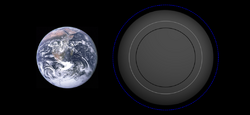Astronomy:Gliese 581e
 Size comparison of Gliese 581e with Earth (Based on selected hypothetical modeled compositions) | |
| Discovery[1] | |
|---|---|
| Discovered by | Mayor et al. |
| Discovery site | La Silla Observatory, Chile |
| Discovery date | 21 April 2009 |
| Radial velocity | |
| Orbital characteristics[3] | |
| 0.029±0.001 astronomical unit|AU | |
| Eccentricity | 0.125+0.078 −0.015 |
| Orbital period | 3.153+0.001 −0.006 d |
| astron|astron|helion}} | 2454752.33 ± 0.05[2] |
| 77.4°+23.0° −43.6° | |
| Semi-amplitude | 1.55+0.22 −0.13 m/s |
| Star | Gliese 581 |
| Physical characteristics[3] | |
| Mean radius | 1.17 R⊕ (estimate) [4] |
| Mass | ≥1.657+0.240 −0.161 M⊕ |
Gliese 581e /ˈɡliːzə/ or Gl 581e is an exoplanet orbiting within the Gliese 581 system, located approximately 20.4 light-years away from Earth in the Libra constellation. It is the third planet discovered in the system (fourth if the disputed planet candidate Gliese 581d is included) and the first in order from the star.
The planet was discovered by an Observatory of Geneva team led by Michel Mayor, using the HARPS instrument on the European Southern Observatory 3.6 m (140 in) telescope in La Silla, Chile . The discovery was announced on 21 April 2009. Mayor's team employed the radial velocity technique, in which the orbit size and mass of a planet are determined based on the small perturbations it induces in its parent star's orbit via gravity.[1]
At a minimum mass of 1.7 Earth masses,[2] it is relatively close in mass to Earth. At an orbital distance of just 0.03 astronomical unit|AU (4,500,000 km) from its parent star, however, it orbits further in than the habitable zone. It is unlikely to possess an atmosphere due to its high temperature and strong radiation from the star. Although scientists think it probably has a rocky surface similar to Earth, it is also likely to experience intense tidal heating similar to (and likely more intense than) that affecting Jupiter's moon Io.[5] Gliese 581e completes an orbit around its parent star in approximately 3.15 days.[1][6][7]
See also
References
- ↑ 1.0 1.1 1.2 Mayor, Michel; Bonfils, Xavier; Forveille, Thierry et al. (2009). "The HARPS search for southern extra-solar planets, XVIII. An Earth-mass planet in the GJ 581 planetary system". Astronomy and Astrophysics 507 (1): 487–494. doi:10.1051/0004-6361/200912172. Bibcode: 2009A&A...507..487M. http://obswww.unige.ch/~udry/Gl581_preprint.pdf.
- ↑ 2.0 2.1 Robertson, Paul; Mahadevan, Suvrath; Endl, Michael; Roy, Arpita (3 July 2014). "Stellar activity masquerading as planets in the habitable zone of the M dwarf Gliese 581". Science 345 (6195): 440–444. doi:10.1126/science.1253253. PMID 24993348. Bibcode: 2014Sci...345..440R.
- ↑ 3.0 3.1 Trifonov, T. et al. (February 2018). "The CARMENES search for exoplanets around M dwarfs. First visual-channel radial-velocity measurements and orbital parameter updates of seven M-dwarf planetary systems". Astronomy & Astrophysics 609: A117. doi:10.1051/0004-6361/201731442. Bibcode: 2018A&A...609A.117T.
- ↑ "GJ 581 e". https://exoplanets.nasa.gov/exoplanet-catalog/6538/gj-581-e/.
- ↑ Barnes, Rory; Jackson, Brian; Greenberg, Richard; Raymond, Sean N. (2009-06-09). "Tidal Limits to Planetary Habitability". The Astrophysical Journal 700 (1): L30–L33. doi:10.1088/0004-637X/700/1/L30. Bibcode: 2009ApJ...700L..30B.
- ↑ Rincon, Paul; Amos, Jonathan (2009-04-21). "Lightest exoplanet is discovered". BBC. http://news.bbc.co.uk/1/hi/sci/tech/8008683.stm.
- ↑ Overbye, Dennis (April 21, 2009). "Astronomers Find Planet Closer to Size of Earth". New York Times. https://www.nytimes.com/2009/04/22/science/22planet.html.
External links
- Lightest exoplanet yet discovered European Southern Observatory press release
- Scientists discover a nearly Earth-sized planet
- Publications at Exoplanet.eu
Coordinates: ![]() 15h 19m 26s, −07° 43′ 20″
15h 19m 26s, −07° 43′ 20″
 |

